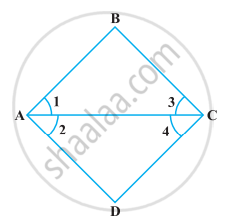Advertisements
Advertisements
प्रश्न
Euclid divided his famous treatise “The Elements” into ______.
पर्याय
13 chapters
12 chapters
11 chapters
9 chapters
उत्तर
Euclid divided his famous treatise “The Elements” into 13 chapters.
APPEARS IN
संबंधित प्रश्न
Consider two ‘postulates’ given below:-
- Given any two distinct points A and B, there exists a third point C which is in between A and B.
- There exist at least three points that are not on the same line.
Do these postulates contain any undefined terms? Are these postulates consistent? Do they follow from Euclid’s postulates? Explain.
How many lines can be drawn through both of the given points?
In how many lines two distinct planes can intersect?
How many planes can be made to pass through two points?
A pyramid is a solid figure, the base of which is ______.
The things which are double of the same thing are equal to one another.
Solve the following question using appropriate Euclid’s axiom:
In the following figure, we have BX = `1/2` AB, BY = `1/2` BC and AB = BC. Show that BX = BY.

Solve the following question using appropriate Euclid’s axiom:
In the following figure, we have ∠1 = ∠3 and ∠2 = ∠4. Show that ∠A = ∠C.

Read the following statements which are taken as axioms:
- If a transversal intersects two parallel lines, then corresponding angles are not necessarily equal.
- If a transversal intersect two parallel lines, then alternate interior angles are equal.
Is this system of axioms consistent? Justify your answer.
Read the following two statements which are taken as axioms:
- If two lines intersect each other, then the vertically opposite angles are not equal.
- If a ray stands on a line, then the sum of two adjacent angles so formed is equal to 180°.
Is this system of axioms consistent? Justify your answer.
